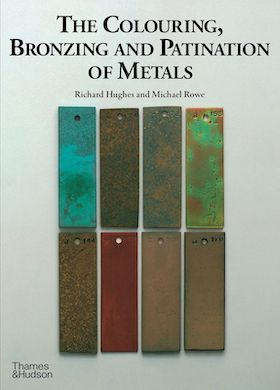
-----
Strange corrosion of copper by vinegar/salt/ammonia
Hello,
I am a student and metal artist, and a few months ago I was researching patinas for copper (for which this site was extremely helpful, BTW) for personal use and for a school paper, and one of the experiments I did to support the paper (it was a chemistry course) was the standard vinegar
⇦in bulk on
eBay
or
Amazon [affil link] /salt/ammonia recipe to create a blue coloring, and it worked magnificently. Yesterday, I was trying this recipe again on a necklace I had made out of copper wire. Though the acetate (blue stuff) appeared to form like it had on my original test piece (a piece of copper plumbing pipe) it all washed off the wire necklace just now, about 32 hours later, along with this bright orange stuff. The entire thing had taken on that bright, "soft" look copper gets when it comes straight out of a pickle after about ten minutes in the solution, so I assumed that the vinegar was "cleaning" the wire (hopefully as a precursor to turning it blue), but I realized before rinsing it that there was some corrosion going on. I have not found any mention of a bright, red-orange substance coming from copper, especially so quickly; not only was the whole piece coated with the stuff, but the wire is completely eaten through in places.
The wire I used is recycled electrical wire that I stripped myself just before using, so I am fairly certain that it IS copper (it is also very soft and easy to bend), but if it is not, does anyone know what metal it could be, based on this reaction?
If it is copper, though, I still do not know what could have caused this reaction. The main difference between this experiment and my original is that, not having any ammonium hydroxide on hand, I used urine (canine) this time around, and in much smaller quantity. I can see how less ammonia gas being present might affect the acetate bonding with the copper, but still does not explain the orange stuff. The material is also different (my first piece was much thicker; while I DEFINITELY didn't see any orange stuff, if it corroded the slightest bit, I wouldn't have been able to tell), and I used store-bought white vinegar this time around, where before I had access to laboratory-grade acetic acid
⇦ on
eBay
or
Amazon [affil link] .
Do any of you professionals out there have any ideas?
student/artist/hobbyist - Austin, Texas
August 22, 2008
by Hughes & Rowe

on eBay or Amazon
or AbeBooks
(affil link)
Clearly, and as you have said, you used a different treatment solution the second time. There is no way that a dog (or any other creature, I'm sure) can generate and pass urine that consists of pure ammonium hydroxide.
If you use a different treatment solution (especially one to which you have added unknown quantities of hundreds of unknown chemical compounds), it is surely reasonable to expect that you would get a different reaction.

Bill Reynolds [deceased]
consultant metallurgist - Ballarat, Victoria, Australia
We sadly relate the news that Bill passed away on Jan. 29, 2010.
Yes, that is true, and I did not expect exactly the same reaction (though several of the recipe recommendations and experiments that were documented online used or suggested the use of urine in place of pure ammonium hydroxide); my question is more related to the corrosion of the copper. When I was researching copper corrosion, I never found a mention of a reaction that would make the copper produce a bright orange substance (not unlike fresh iron rust) and then dissolve within a day. If anyone knows what could cause this reaction in what I believe to be copper wire, I would appreciate it.
Stella Bell (returns)student/artist/hobbyist - Austin, Texas
August 26, 2008
April 22, 2009
Urine only develops ammonia after it has been standing for some days and goes cloudy. I doubt that fresh urine would do anything much.
Vinegar + salt cleans oxides right off copper, and can eat into it as well. It's a good cleaner for jewellery. That's what happened with yours I assume. I don't have the chemical reaction details, sorry. I would assume that the presence of ammonia instead forms a blue patina.
The bright red colour seen sometimes on copper is probably an oxide. I've seen it form in the presence of acetic acid vapour (along with verdigris), but I assume it's oxygen the copper's reacting with.
- Darwin, NT, Australia
It's a little late, but it sounds like what you've got is copper(1) oxide (Cu2O) instead of the intended copper(II) oxide (such as CuSO4). I would assume that the vinegar/urine/salts mixture you created produced this oxide preferentially, although determining why would require knowledge of the chemicals involved, which using dog urine and store bought white vinegar preclude.
Zohar Edelkind- Rome, Georgia, USA
February 9, 2011
Q, A, or Comment on THIS thread -or- Start a NEW Thread